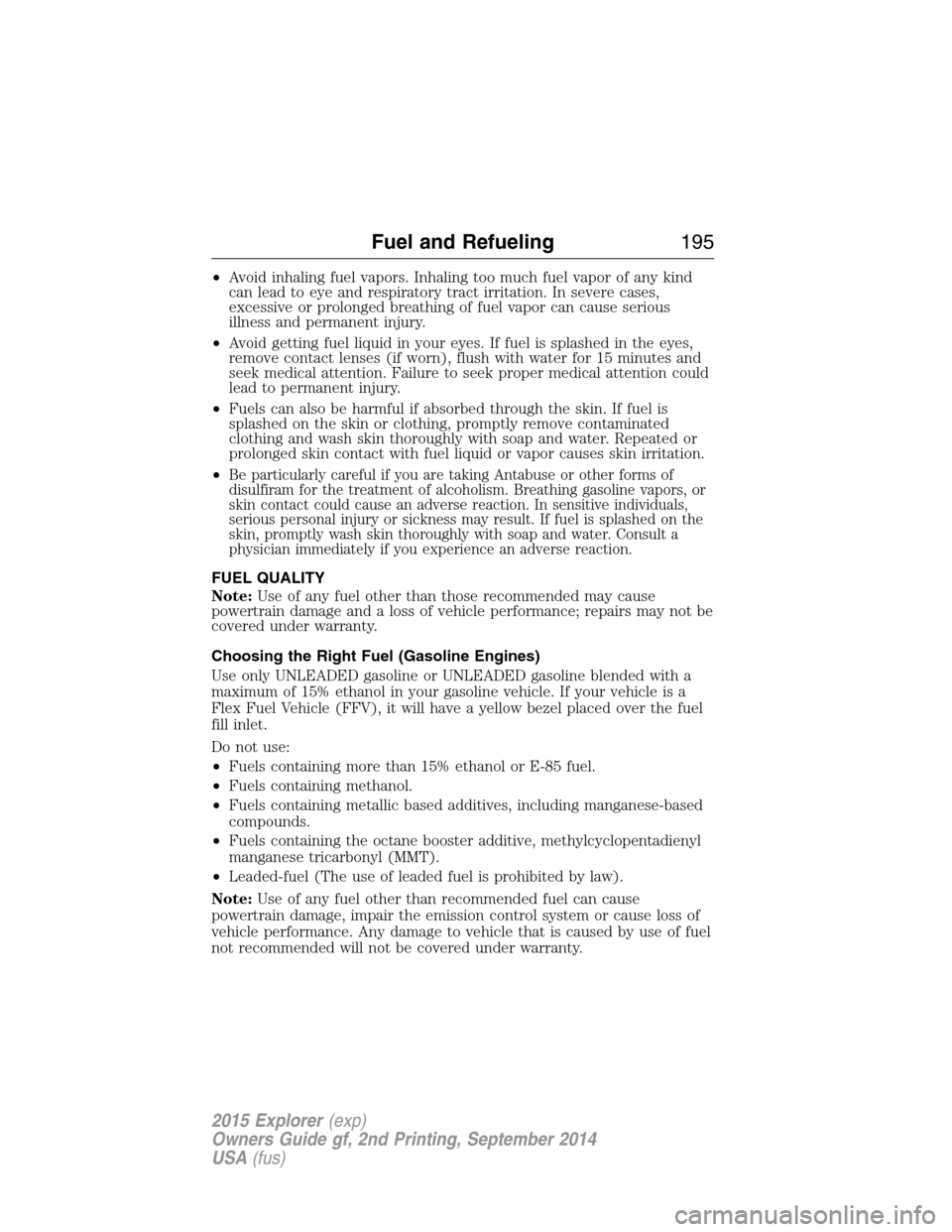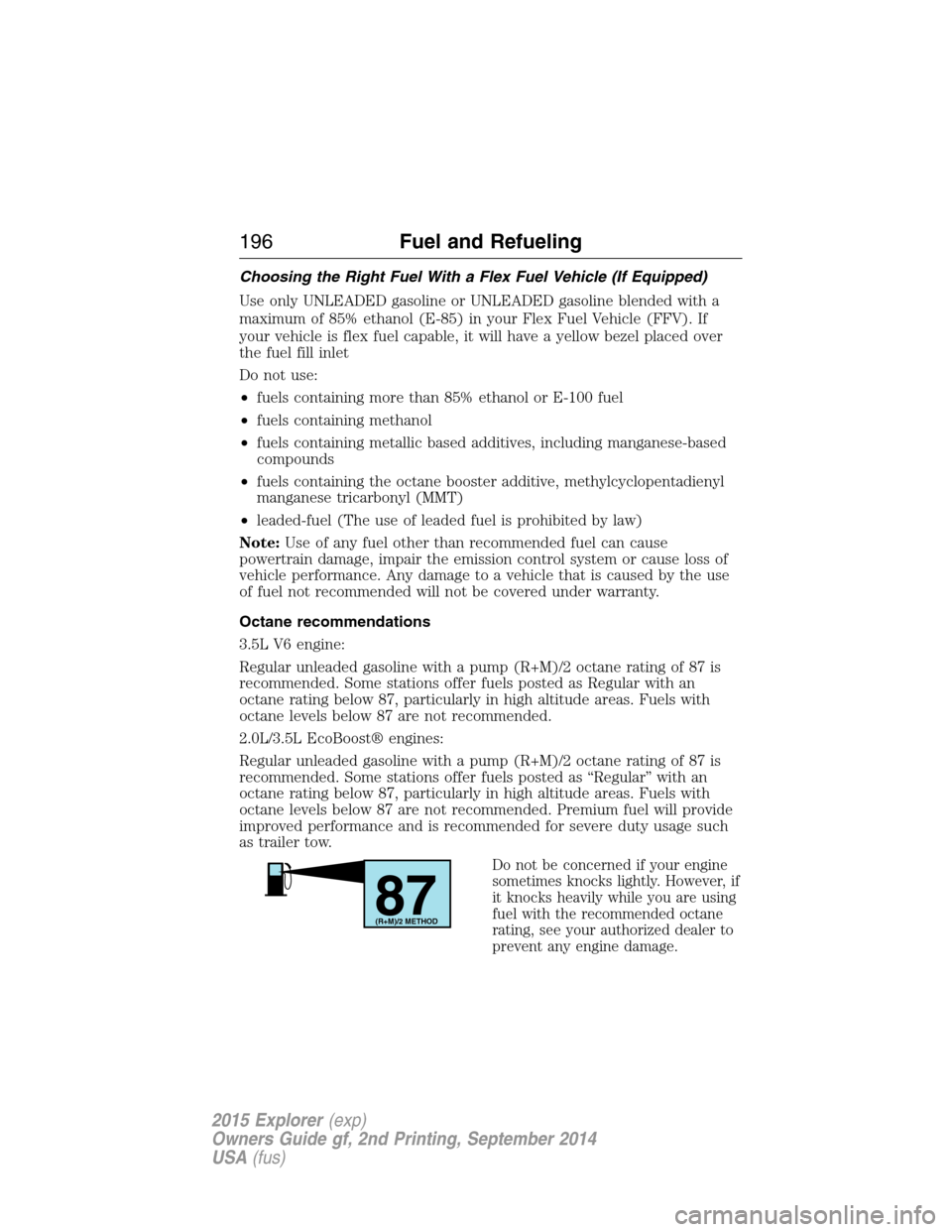2015 FORD EXPLORER octane
[x] Cancel search: octanePage 196 of 596

•Avoid inhaling fuel vapors. Inhaling too much fuel vapor of any kind
can lead to eye and respiratory tract irritation. In severe cases,
excessive or prolonged breathing of fuel vapor can cause serious
illness and permanent injury.
•Avoid getting fuel liquid in your eyes. If fuel is splashed in the eyes,
remove contact lenses (if worn), flush with water for 15 minutes and
seek medical attention. Failure to seek proper medical attention could
lead to permanent injury.
•Fuels can also be harmful if absorbed through the skin. If fuel is
splashed on the skin or clothing, promptly remove contaminated
clothing and wash skin thoroughly with soap and water. Repeated or
prolonged skin contact with fuel liquid or vapor causes skin irritation.
•
Be particularly careful if you are taking Antabuse or other forms of
disulfiram for the treatment of alcoholism. Breathing gasoline vapors, or
skin contact could cause an adverse reaction. In sensitive individuals,
serious personal injury or sickness may result. If fuel is splashed on the
skin, promptly wash skin thoroughly with soap and water. Consult a
physician immediately if you experience an adverse reaction.
FUEL QUALITY
Note:Use of any fuel other than those recommended may cause
powertrain damage and a loss of vehicle performance; repairs may not be
covered under warranty.
Choosing the Right Fuel (Gasoline Engines)
Use only UNLEADED gasoline or UNLEADED gasoline blended with a
maximum of 15% ethanol in your gasoline vehicle. If your vehicle is a
Flex Fuel Vehicle (FFV), it will have a yellow bezel placed over the fuel
fill inlet.
Do not use:
•Fuels containing more than 15% ethanol or E-85 fuel.
•Fuels containing methanol.
•Fuels containing metallic based additives, including manganese-based
compounds.
•Fuels containing the octane booster additive, methylcyclopentadienyl
manganese tricarbonyl (MMT).
•Leaded-fuel (The use of leaded fuel is prohibited by law).
Note:Use of any fuel other than recommended fuel can cause
powertrain damage, impair the emission control system or cause loss of
vehicle performance. Any damage to vehicle that is caused by use of fuel
not recommended will not be covered under warranty.
Fuel and Refueling195
2015 Explorer(exp)
Owners Guide gf, 2nd Printing, September 2014
USA(fus)
Page 197 of 596

Choosing the Right Fuel With a Flex Fuel Vehicle (If Equipped)
Use only UNLEADED gasoline or UNLEADED gasoline blended with a
maximum of 85% ethanol (E-85) in your Flex Fuel Vehicle (FFV). If
your vehicle is flex fuel capable, it will have a yellow bezel placed over
the fuel fill inlet
Do not use:
•fuels containing more than 85% ethanol or E-100 fuel
•fuels containing methanol
•fuels containing metallic based additives, including manganese-based
compounds
•fuels containing the octane booster additive, methylcyclopentadienyl
manganese tricarbonyl (MMT)
•leaded-fuel (The use of leaded fuel is prohibited by law)
Note:Use of any fuel other than recommended fuel can cause
powertrain damage, impair the emission control system or cause loss of
vehicle performance. Any damage to a vehicle that is caused by the use
of fuel not recommended will not be covered under warranty.
Octane recommendations
3.5L V6 engine:
Regular unleaded gasoline with a pump (R+M)/2 octane rating of 87 is
recommended. Some stations offer fuels posted as Regular with an
octane rating below 87, particularly in high altitude areas. Fuels with
octane levels below 87 are not recommended.
2.0L/3.5L EcoBoost® engines:
Regular unleaded gasoline with a pump (R+M)/2 octane rating of 87 is
recommended. Some stations offer fuels posted as “Regular” with an
octane rating below 87, particularly in high altitude areas. Fuels with
octane levels below 87 are not recommended. Premium fuel will provide
improved performance and is recommended for severe duty usage such
as trailer tow.
Do not be concerned if your engine
sometimes knocks lightly. However, if
it knocks heavily while you are using
fuel with the recommended octane
rating, see your authorized dealer to
prevent any engine damage.
87(R+M)/2 METHOD
196Fuel and Refueling
2015 Explorer(exp)
Owners Guide gf, 2nd Printing, September 2014
USA(fus)
Page 385 of 596

ENGINE SPECIFICATIONS
Engine 3.5L V6 engine3.5L V6
EcoBoost
engine2.0L EcoBoost
engine
Cubic inches 214 214 122
Required fuelMinimum
87 octaneMinimum
87 octaneMinimum
87 octane
Firing order 1–4–2–5–3–6 1–4–2–5–3–6 1-3-4-2
Ignition
systemCoilonplug Coilonplug Coilonplug
Spark plug
gap0.049-0.053 in.
(1.25-1.35 mm)0.033–0.037 in.
(0.85–0.95 mm)0.027–0.031 in.
(0.70–0 .80 mm)
Compression
ratio10.8:1 10.0:1 9.3:1
384Capacities and Specifications
2015 Explorer(exp)
Owners Guide gf, 2nd Printing, September 2014
USA(fus)
Page 591 of 596

Dipstick
automatic transmission
fluid ..........................................322
engine oil .................................315
Display settings .........................519
Driver alert ................................248
Driving under special
conditions ..................211, 214, 216
sand .........................................215
snow and ice ...........................217
through water .................216, 284
Dual automatic temperature
control (DATC) .................146, 148
E
Electronic message center .......123
Electronic stability control ......224
Emergencies, roadside
jump-starting ..........................289
running out of fuel .................197
Emergency brake
(see Parking brake) ..................220
Emission control system ..........202
End user license agreement ....552
Engine ........................................384
cleaning ...................................343
coolant .....................................316
fail-safe cooling .......................320
idle speed control ...................327
lubrication specifications .......386
refill capacities ........................386
service points ..................312–314
Engine block heater .................192
Engine oil
checking and adding ..............315
dipstick ....................................315
filter, specifications ................391refill capacities ........................386
specifications ..........................386
Event data recording ..................13
Exhaust fumes ..........................192
F
Fail safe cooling ........................320
Fleet MyKey programming ........69
Floor mats .................................284
Fluid capacities .........................386
Fuel
cap ...........................................199
capacity ...................................386
choosing the right fuel ...195–196
filler funnel .............................197
filling your vehicle with fuel ..199
filter, specifications ........327, 391
fuel pump shut-off ..................288
octane rating ...........................384
quality ......................................195
running out of fuel .................197
safety information relating to
automotive fuels .....................194
Fuel and distance computer ....127
outside temperature
indicator ..................................127
to empty indicator ..................127
trip distance ............................127
trip/reset button .....................127
Fuel - flex fuel vehicle
(FFV) .........................................196
Fuses ..................................300, 306
G
Garage door opener ..................177
Gas cap (see Fuel cap) ............199
590Index
2015 Explorer(exp)
Owners Guide gf, 2nd Printing, September 2014
USA(fus)